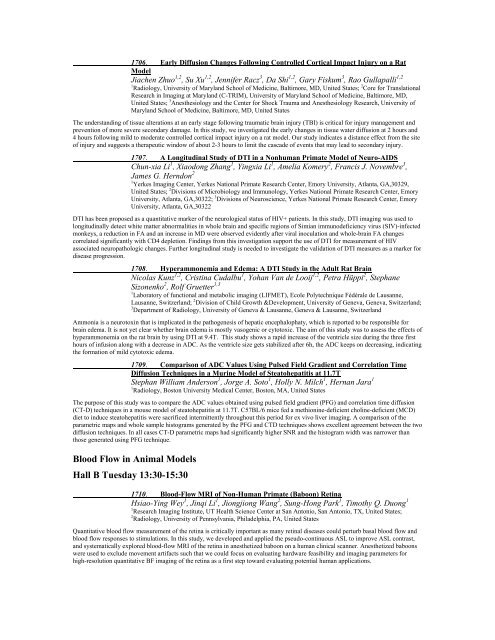Traditional Posters: Diffusion & Perfusion - ismrm
Traditional Posters: Diffusion & Perfusion - ismrm
Traditional Posters: Diffusion & Perfusion - ismrm
You also want an ePaper? Increase the reach of your titles
YUMPU automatically turns print PDFs into web optimized ePapers that Google loves.
1706. Early <strong>Diffusion</strong> Changes Following Controlled Cortical Impact Injury on a Rat<br />
Model<br />
Jiachen Zhuo 1,2 , Su Xu 1,2 , Jennifer Racz 3 , Da Shi 1,2 , Gary Fiskum 3 , Rao Gullapalli 1,2<br />
1 Radiology, University of Maryland School of Medicine, Baltimore, MD, United States; 2 Core for Translational<br />
Research in Imaging at Maryland (C-TRIM), University of Maryland School of Medicine, Baltimore, MD,<br />
United States; 3 Anesthesiology and the Center for Shock Trauma and Anesthesiology Research, University of<br />
Maryland School of Medicine, Baltimore, MD, United States<br />
The understanding of tissue alterations at an early stage following traumatic brain injury (TBI) is critical for injury management and<br />
prevention of more severe secondary damage. In this study, we investigated the early changes in tissue water diffusion at 2 hours and<br />
4 hours following mild to moderate controlled cortical impact injury on a rat model. Our study indicates a distance effect from the site<br />
of injury and suggests a therapeutic window of about 2-3 hours to limit the cascade of events that may lead to secondary injury.<br />
1707. A Longitudinal Study of DTI in a Nonhuman Primate Model of Neuro-AIDS<br />
Chun-xia Li 1 , Xiaodong Zhang 1 , Yingxia Li 1 , Amelia Komery 2 , Francis J. Novembre 3 ,<br />
James G. Herndon 2<br />
1 Yerkes Imaging Center, Yerkes National Primate Research Center, Emory University, Atlanta, GA,30329,<br />
United States; 2 Divisions of Microbiology and Immunology, Yerkes National Primate Research Center, Emory<br />
University, Atlanta, GA,30322; 3 Divisions of Neuroscience, Yerkes National Primate Research Center, Emory<br />
University, Atlanta, GA,30322<br />
DTI has been proposed as a quantitative marker of the neurological status of HIV+ patients. In this study, DTI imaging was used to<br />
longitudinally detect white matter abnormalities in whole brain and specific regions of Simian immunodeficiency virus (SIV)-infected<br />
monkeys, a reduction in FA and an increase in MD were observed evidently after viral inoculation and whole-brain FA changes<br />
correlated significantly with CD4 depletion. Findings from this investigation support the use of DTI for measurement of HIV<br />
associated neuropathologic changes. Further longitudinal study is needed to investigate the validation of DTI measures as a marker for<br />
disease progression.<br />
1708. Hyperammonemia and Edema: A DTI Study in the Adult Rat Brain<br />
Nicolas Kunz 1,2 , Cristina Cudalbu 1 , Yohan Van de Looij 1,2 , Petra Hüppi 2 , Stephane<br />
Sizonenko 2 , Rolf Gruetter 1,3<br />
1 Laboratory of functional and metabolic imaging (LIFMET), Ecole Polytechnique Fédérale de Lausanne,<br />
Lausanne, Switzerland; 2 Division of Child Growth &Development, University of Geneva, Geneva, Switzerland;<br />
3 Department of Radiology, University of Geneva & Lausanne, Geneva & Lausanne, Switzerland<br />
Ammonia is a neurotoxin that is implicated in the pathogenesis of hepatic encephalophaty, which is reported to be responsible for<br />
brain edema. It is not yet clear whether brain edema is mostly vasogenic or cytotoxic. The aim of this study was to assess the effects of<br />
hyperammonemia on the rat brain by using DTI at 9.4T. This study shows a rapid increase of the ventricle size during the three first<br />
hours of infusion along with a decrease in ADC. As the ventricle size gets stabilized after 6h, the ADC keeps on decreasing, indicating<br />
the formation of mild cytotoxic edema.<br />
1709. Comparison of ADC Values Using Pulsed Field Gradient and Correlation Time<br />
<strong>Diffusion</strong> Techniques in a Murine Model of Steatohepatitis at 11.7T<br />
Stephan William Anderson 1 , Jorge A. Soto 1 , Holly N. Milch 1 , Hernan Jara 1<br />
1 Radiology, Boston University Medical Center, Boston, MA, United States<br />
The purpose of this study was to compare the ADC values obtained using pulsed field gradient (PFG) and correlation time diffusion<br />
(CT-D) techniques in a mouse model of steatohepatitis at 11.7T. C57BL/6 mice fed a methionine-deficient choline-deficient (MCD)<br />
diet to induce steatohepatitis were sacrificed intermittently throughout this period for ex vivo liver imaging. A comparison of the<br />
parametric maps and whole sample histograms generated by the PFG and CTD techniques shows excellent agreement between the two<br />
diffusion techniques. In all cases CT-D parametric maps had significantly higher SNR and the histogram width was narrower than<br />
those generated using PFG technique.<br />
Blood Flow in Animal Models<br />
Hall B Tuesday 13:30-15:30<br />
1710. Blood-Flow MRI of Non-Human Primate (Baboon) Retina<br />
Hsiao-Ying Wey 1 , Jinqi Li 1 , Jiongjiong Wang 2 , Sung-Hong Park 1 , Timothy Q. Duong 1<br />
1 Research Imaging Institute, UT Health Science Center at San Antonio, San Antonio, TX, United States;<br />
2 Radiology, University of Pennsylvania, Philadelphia, PA, United States<br />
Quantitative blood flow measurement of the retina is critically important as many retinal diseases could perturb basal blood flow and<br />
blood flow responses to stimulations. In this study, we developed and applied the pseudo-continuous ASL to improve ASL contrast,<br />
and systematically explored blood-flow MRI of the retina in anesthetized baboon on a human clinical scanner. Anesthetized baboons<br />
were used to exclude movement artifacts such that we could focus on evaluating hardware feasibility and imaging parameters for<br />
high-resolution quantitative BF imaging of the retina as a first step toward evaluating potential human applications.















